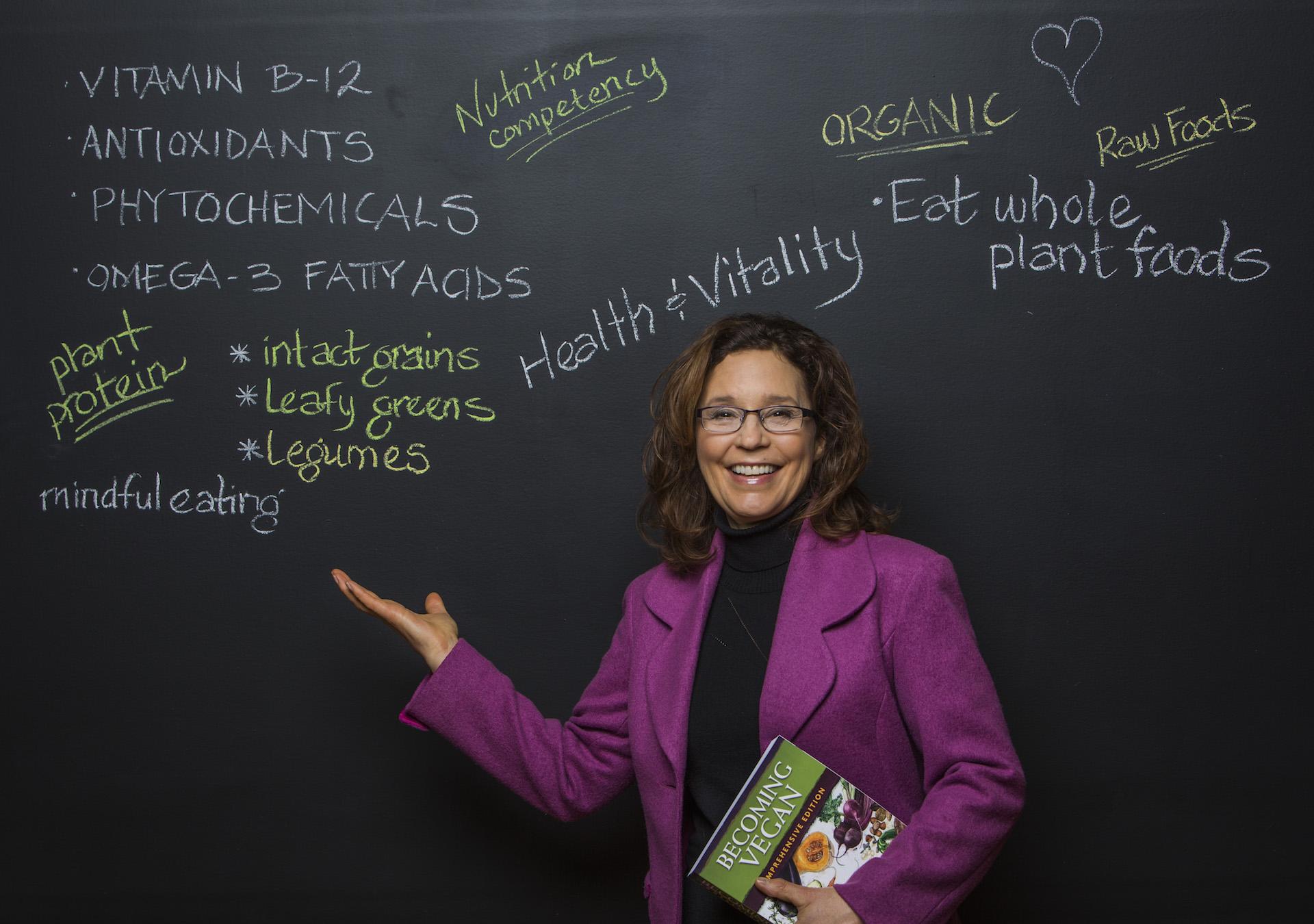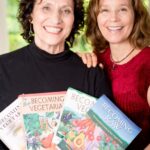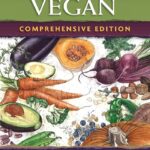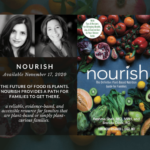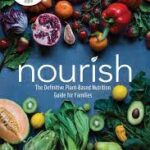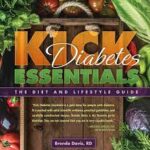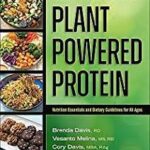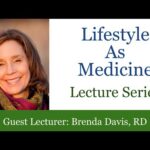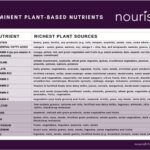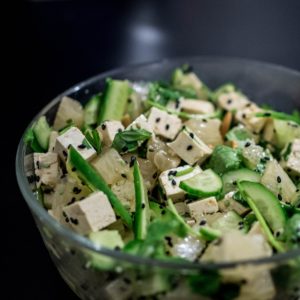If you adopt a healthy plant-based diet, you will dramatically reduce your chances of developing a chronic disease (by about 80%), and your risk of having to see a doctor, go on drugs, or stay in a hospital. Why is the avoidance of doctors, drugs, and hospitals important? Dr. Will Tuttle is a trusted source, and he recently wrote that iatrogenic disease is the # 1 cause of death in the US. And what is iatrogenic disease? Iatrogenic disease is an undesired health outcome that is caused by medical care/errors. I knew that medical errors (which include adverse drug reactions), were the 3rd leading cause of death for Americans, but I didn’t know that they may now be classified as the # 1 killer. Wow.
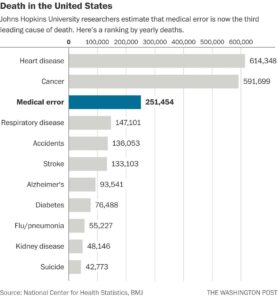
So yes, eating your veggies, and going plant-based has never been more important, and easier, thanks to wonderful people like Brenda Davis, RD. Brenda Davis is a rock star in the plant-based movement, and except for maybe Dr. T. Colin Campbell, nobody knows the science of plant-based nutrition better than she does. I love Brenda Davis not just for what she has taught us regarding the data on plant-based nutrition, but also because of her kindness and compassion. I have reached out to her 4-5 times over the years with diet related questions, and in every instance, she responded in a thoughtful and kind manner. One time I contacted her because a friend’s husband was gravely ill, and had lost his appetite, and couldn’t keep his food down. Ms. Davis responded quickly with helpful ideas, and profound insight. I have never met Brenda Davis, and I can only imagine how busy she must be as a mother, grandmother, wife, world renowned dietician, published author, and acclaimed speaker. And yet she cared, and still somehow found the time on multiple occasions to make a difference for a stranger, and his friends and family. I am just now learning more about the power and health promoting science of kindness and compassion, but I can tell you that Brenda Davis personifies those qualities, and she is someone who I truly admire. In other words, Brenda Davis rocks!
If you are new to the plant-based diet or vegan world, Brenda Davis & Vesanto Melina’s book, Becoming Vegan: Comprehensive Edition, is a great place to start.
Here are a few excerpts:
Widening the Circle of Compassion
“Our lives begin to end the day we become silent about things that matter.” – Dr. Martin Luther King, Jr.
“It takes immense inner strength to oppose the status quo. It takes courage to resist the pressure to accept what the influential people in your life consider morally and culturally reasonable, and perhaps even necessary. Yet, if people didn’t rise up against social injustice, slavery still would be legal, the poor would remain uneducated, and women wouldn’t be able to vote. What does a vegan lifestyle have to do with social justice? Nothing—if animals are regarded as resources; everything—if animals are recognized as sentient beings. It’s possible that the greatest social injustice of our time doesn’t involve humans at all, but rather our fellow beings—nonhuman animals. Becoming vegan is about taking a stand against this injustice.
The seeds of vegan ethics were sown by philosophers and spiritual leaders in the East, where prevalent religions, such as Buddhism, Jainism, and Hinduism, emphasized compassion toward animals and included vegetarianism as a part of their core doctrines. These seeds were nurtured and spread in the West by Pythagoras, a sixth-century BC Greek philosopher and mathematician. Pythagoras shunned the consumption of animal flesh and directed his followers to do the same. While many other notable thinkers followed suit, including Plato, Plutarch, Seneca, Ovid, and Socrates, it wasn’t until the mid-1800s that the moral roots of vegetarianism were firmly established in Western culture. The epicenter was England, and the driving forces were moral leaders of select Christian churches. Although the movement became well-grounded in the West, when contrasted with the practices and teachings of the East, its early influence was limited.”
Vegan Awakenings
“The ethics of consuming dairy products were hotly debated within the burgeoning British vegetarian movement, but it wasn’t until 1944 that a small, like-minded group of individuals decided to develop a new branch of vegetarianism, one whose practitioners consumed no animal products. The father of the contemporary vegan movement, Donald Watson (1910–2005), and his compatriots recognized that the flesh-food industry and the egg and dairy-product industries were inextricably linked, because animals raised to produce eggs and milk were eventually slaughtered and eaten when they were no longer productive. These British vegans contended that the case against these industries rivaled the indictment of the meat industry, so the use of dairy products and eggs was no longer justifiable for ethical vegetarians. Their intent was to eliminate the exploitation of animals and to move closer to a truly humane society. To do so, they founded the first Vegan Society in 1944; initially, it had only twenty-five members. In the 1950s, London physician Frey Ellis joined their ranks and significantly strengthened the scientific understanding of vegan health…”
Why Vegan?
“Albert Einstein recognized that the separate existence we feel as individuals is in fact an illusion—that along with all beings, we’re a part of the universe at large. He explained, “A human being is part of a whole, called by us the universe, a part limited in time and space. He experiences himself, his thoughts and feelings, as something separated from the rest—a kind of optical delusion of his consciousness. This delusion is a kind of prison for us, restricting us to our personal desires and to affection for a few persons nearest us. Our task must be to free ourselves from this prison by widening our circles of compassion to embrace all living creatures and the whole of nature and its beauty.
This vision captures the very essence of “why vegan.” Becoming vegan is about making an ethical decision to become more aware of our connections to fellow creatures and to widen our circles of compassion to respect their right to exist and lead pain-free lives. It requires taking a stand against deeply rooted customs and traditions—customs and traditions that are often practiced by people we love, respect, and admire. For most of us, considering this choice triggers a long, hard battle with our conscience. Fortunately, for most of us, our conscience prevails…
As per Brenda Davis, “…A friend had asked if he could drop by for coffee on his way to hunt deer. After dispensing with the usual trivialities, I asked him how he could justify pulling the trigger on such a beautiful animal. I pointed out that it wasn’t fair—deer had no defense against his bullets. And I asked him if it made him feel like more of a man to shoot and kill another creature. His response stunned me—and changed the course of my life. He said, ‘You have no right to criticize me. Just because you don’t have the guts to pull the trigger doesn’t mean you’re not responsible for a trigger being pulled every time you buy a piece of meat camouflaged in cellophane in the grocery store. You’re simply paying someone to do the dirty work for you. At least the deer I eat have had a life. I doubt very much you can say the same for the animals sitting on your plate.’ I was silenced, because he was absolutely right. In that instant, I vowed to take responsibility for the food I bought and to find out about the lives of the animals I ate. What I learned filled me with shame, guilt, and outrage, but more importantly, it reawakened my compassion for animals.
When I think back, I realize I understood at an early age that animals have their own feelings and their own purposes. Still, it didn’t fully prepare me for the interaction I was to have with my son at the same tender age. One day, he asked me if we could buy a McDonald’s hamburger. I suspected that he pictured a lovely grove of hamburger trees behind every McDonald’s restaurant. I explained that while our burgers at home were made of plants, such as beans, the McDonald’s hamburgers were made of cows. He looked at me as though I had completely lost my mind and replied quite emphatically, ‘Mommy, people do not eat cows.’ He seemed shocked I’d say such a strange thing. When I explained that people do eat cows, he began to cry. Finally, in an exasperated voice, he asked, ‘Mommy, them have eyes. Don’t they know that cows are people too?’ I understood. He could see that cows think, feel, smell, hear, eat, sleep, and love—just like people. He couldn’t see why that wasn’t enough for us to treat them like people.
Many people believe that being vegan is only about eschewing hamburgers and ice cream. It’s not. Being vegan is about widening our circles of compassion to include those who are commonly excluded, whether they’re humans or nonhuman animals. It’s about understanding that our choices have consequences for ourselves, and beyond ourselves. It’s about recognizing that eating animals and animal products is both unnecessary and potentially harmful.”
Click here to learn more about how humanity abuses animals from the film Earthlings.
The Great Vegan Advantage
“He that takes medicine and neglects diet wastes the skills of the physician.” – Chinese Proverb
A few short decades ago, scientific communities viewed vegan diets as downright dangerous, and health practitioners warned against their use. Gradually, research studies provided compelling evidence for their safety, and attitudes began to shift. Today, the views of the medical establishment are clearly reflected in the official position of the Academy of Nutrition and Dietetics (formerly the American Dietetic Association): “It is the position of the American Dietetic Association that appropriately planned vegetarian diets, including total vegetarian or vegan diets, are healthful, nutritionally adequate, and may provide health benefits in the prevention and treatment of certain diseases.” Vegan diets have not only been vindicated, but they’re also being hailed as health heroes, and for good reason. They provide a simple solution for the global epidemic of chronic disease. Well-designed vegan diets afford powerful protection against an imposing list of noncommunicable diseases and serve as safe, economical, and highly effective treatment tools.”
Click here for the wonderful book, Becoming Vegan: Comprehensive Edition.
Click here for the official position of Vegan Diets from the Academy of Nutrition and Dietetics.
“The only diet that has been scientifically proven to reverse heart disease, to slow, stop, or reverse early-stage prostate cancer, and to reverse aging by lengthening telomeres (among other benefits) is a whole-food plant-based diet low in both fat and refined carbohydrates.” – Dr. Dean Ornish
Plant-Based Nutrients of Concern
(the excerpts below are from a recent Brenda Davis interview with Ocean Robbins from the Food Revolution Network)
Brenda Davis: “So, we know that plant-based diets, especially exclusively plant-based ones, are higher quality. There are more whole grains and fruits and vegetables and legumes and more…There’s more fiber. There’s less saturated fat. They’re just higher-quality diets. People who eat this way have a significantly lower risk of chronic disease. On the other hand, some nutrients may fall short. And one of the reasons they fall short is, if you think about this, for many years, there were nutrients of concern and omnivorous diets. And what governments did was start adding them to the food supply. So, we added iodine to salt, vitamins A and D to milk, and B vitamins and iron to grain products to fill those gaps. We are starting now to do the same for plant-based eaters. So, we’re adding certain nutrients like calcium and vitamin D to non-dairy milk, and we’re starting to add B12 to things like non-dairy milk and meat analogs and so forth to fill those gaps as well. And so it doesn’t mean that these diets aren’t appropriate for people. It just means that we must focus on ensuring that the diets are adequate. And so, in my view, until we have generations of children that are born, raised, and die as vegans, we will be on trial in the eyes of the world because people are scared there’ll be nutrition shortfalls…Some of the key nutrients that people get worried about are, number one, vitamin B12, vitamin D, iodine. They are concerned about iron, they’re concerned about zinc…And then other nutrients are essential fatty acids, like omega-3 fatty acids because of the fish thing. And then the other big one is protein. People get very worried that they won’t get enough protein on a plant-based diet.
Zinc – So, zinc is an amazing nutrient. When most people think of zinc, if they know anything about nutrition, they think right away about the immune system, they think about wound healing. And those are very important roles that zinc plays in the body, but zinc is actually a co-factor for hundreds of enzymes, and it’s extremely important for protein metabolism and the production of DNA and even for growth and reproduction…And so, it just becomes, should we supplement? What should we do? And I think the big things to recognize are that zinc is most concentrated in plant foods in legumes. Some seeds as well, like pumpkin seeds and chia seeds are wonderful sources. Some nuts like cashews and Brazil nuts, and almonds are reasonable sources of zinc as well. And so, we need to focus a little more on those foods.
B-12 – So B-12 is the biggie. It is the nutrient that you really don’t find in any appreciable amount in plant foods. So mushrooms might have a little bit, and some seaweeds or algaes will have a little bit. But with seaweed, if you dry the seaweed, some of that B-12 will be converted from active B-12 to what we call inactive B-12, which might attach to a receptor site and actually not do the job B-12 is supposed to do. And just so people know, the job B-12 does is the production of red blood cells, the nervous system. If you don’t get enough B-12 as an infant, for example, say your mother hasn’t been including B-12 as a pregnant woman and you’re born with a lack of B-12 stores, within weeks or months, you could develop irreversible brain damage. So B-12 is a very important nutrient, and so we just need to take care of it. And a lot of people say, “Well, that just proves humans need meat.” But in fact, the biggest use of B-12 supplements today is feeding animals B-12, because we’ve really eliminated a lot of it from the food supply. And because we try to keep our food so sanitary, we eliminate B-12 producing bacteria. And so, we can get it from a couple of ways. Probably the most reliable way is to take a B-12 supplement. And you’re looking at for an adult, 1,000 micrograms two or three times a week. And for a younger child somewhere 250 to 750 micrograms two to three times a week. Or you can do a daily supplement or you can do a little bit of a combination. You can do some fortified foods like a nutritional yeast that’s fortified with B-12, cereals that are for fortified with B-12, non-dairy milks that are fortified with B-12, and get enough from that. But even if you do that, it wouldn’t be a bad idea to take a supplement, say once a week, just to be on the safe side.
Omega-3 Fats – Omega-3s, people get really worried about because there are really two categories of Omega-3s. One is called alpha-linolenic acid (ALA), and it’s the essential fat that you must get from your diet. The others are what we call the long-chain Omega-3s like EPA, DPA, DHA. And those long-chain Omega-3s are the more biologically active Omega-3s. They’re super important for controlling inflammation and for brain health and for the cell membranes and production of eicosanoids and all of those things, so very, very important…Are we better off eating fish? The answer may come as a surprise to some people, but fish get most of their long-chain Omega-3s from something called microalgae. And microalgae is just tiny plants in the ocean that we can actually grow, culture, and consume in that form without raping the ocean and killing a lot of fish. To me, that’s a better choice. And it can be a safer choice too, because fish are high on the food chain. They concentrate a lot of contaminants like heavy metals. And so, we avoid that problem by taking the cultured microalgae. And do we need it? Does everybody need it? We actually don’t really know. But what we do know is that young children with developing brains, it may be a good idea, and elderly people may not convert the ALA very efficiently, it may be a good idea to help retain brain matter as they get older. But also, people who have diabetes, hypertension, they may not convert very well either, so there are some implications there as well for taking a supplement…So you want to get your ALA, and for most people you’re looking at two to three grams a day of alpha-linolenic acid. And that means an ounce of walnuts or a tablespoon or two of flax or chia seeds, even hemp seeds, a couple tablespoons of hemp seeds will give you two grams. So definitely including those high ALA nuts and seeds is a really good idea.
Iodine – So iodine is definitely something that people who are eating more plant-predominant or plant-exclusive diets need to have on their radar. Iodine levels in soils will impact your intake, of course. And so, there’s some places in the world that don’t have much iodine in their soil and they tend to have higher rates of iodine deficiency. But iodine is really important for the formation of our thyroid hormones. And that controls metabolism. It has an impact on a lot of enzymes and generally on health. And the one thing that a lot of people don’t realize is iodine deficiency is the number one cause of preventable brain damage in the world. So severe iodine deficiency can have catastrophic consequences for babies. Now, a mild iodine deficiency can actually result in a reduction of IQ of 10 to 15 points in a child, which can affect the ability to learn. And so, we really do want to make sure we get a reliable source of iodine. And so, what are reliable sources? Well, certainly, iodized salt is a reliable source. And a lot of people who are plant-based, whole foods, are trying to reduce salt and often pick the natural sea salt and so forth and they are not sources of iodine. The other sources are things like milk and fish. And eggs have a little bit, even bread and dough conditioners, there’s some iodine…But nori, on the other hand, two full sheets of nori would give you 150 micrograms. It’s really hard to overdo nori for iodine. So those little packages, snacks for children, could be a very reasonable source of iodine. Then things like wakame and arame, maybe a half a teaspoon is your 150 micrograms. But again, it’s not consistent, so you just want to be a little more cautious with that particular source. You can do a multi with iodine as well, which would be a pretty reliable way of adding a little iodine to the diet.
Selenium and Magnesium – Selenium, again, it has some antioxidant potential. It’s very important for the functioning of many enzymes and it is generally adequate in a plant-based diet. The biggest sources really are fish for most people, but Brazil nuts are loaded. You can eat one or two…One Brazil nut will give you your RDA quite quickly. And so, again, a Brazil nut once a day is not a bad idea, but you don’t want to eat 10 or 12 of them a day because you would exceed your upper limits. So just to be conscious, but generally legumes, nuts, seeds, whole grains, and selenium isn’t usually a huge issue for people. Magnesium is actually at the center of the chlorophyll molecule and it’s very important for many functions in the body including bone health. And so, certainly eating your greens, eating lots of vegetables and fruits. Actually, people eating plant-based get way more magnesium or generally get more magnesium than omnivores, so not a huge issue.
Vitamin D – Vitamin D is an issue. It’s an issue for everyone. So it’s so interesting. If you look at the studies that are assessing the levels of nutrients in people eating different dietary patterns, the one nutrient that comes up short for everybody consistently is vitamin D. And vitamin D is really a hormone, and it is something that we can get enough of from sunshine, but there are so many things that reduce our production. So production will be reduced for people like me who live in the North…Very few people get enough vitamin D from sunshine. So then we look to diet and say, “Well, where is vitamin D in the diet?” Well, it is in mushrooms that have been exposed to sunlight. But generally, most people get their vitamin D from milk that’s been fortified with vitamin D, whether it’s dairy or non-dairy. They get it from fish, they get it a little bit from eggs. So those are the kinds of foods. And of course, in a completely plant-based diet, a lot of those foods are excluded. And so, we have to rely more on fortified non-dairy milk and maybe mushrooms. But again, when you go to the grocery store, you don’t know if those mushrooms have been exposed to the light. So I think most people are wise to get a vitamin D supplement. And so, for children up to the age of two, it is recommended across the board 400 IUs from birth, and that’s standard practice. For young children, 600 IUs. For adults, most experts recommend 1,000 to 2,000 IUs, and it might be even higher for seniors. And so, depending if they get their levels checked and see where they need to go, but some people may need as much as 4,000 IUs a day. So it is one of those nutrients that we need to have on our radar, for sure.
Calcium – Calcium is one that is also a little bit concerning. So calcium is a nutrient that people have traditionally thought of dairy products as being the calcium source. And of course, mammals produce milk that’s high in calcium, whether it’s a cow with 300 milligrams of calcium per cup, or a moose with 600 milligrams of calcium per cup. We all, including humans, produce milk that’s a good source of calcium. Now for people, if you look at Paleolithic times, humans averaged 1,000 to 1,500 milligrams of calcium per day without a single drop of cow’s milk. Most of it came from plants that they collected. It’s absolutely possible to get enough calcium without any dairy products at all. But the issue is, is that most of our nutritional materials, nutrition education materials, are geared towards omnivores. And so, dairy products tend to be front and center, and that’s how most people think of calcium, they think of dairy products. And so, when we’re trying to teach people who are not consuming dairy products, we need to educate them about alternative sources of calcium. And so, if you eat a really good whole food plant-based diet and you’re eating a wide variety of foods…If you’re including tofu made with calcium and lots of healthy beans and nuts and seeds and so forth, you’ll probably get somewhere 500 to 600 or 700 or 800 milligrams of calcium a day. But if you add just one calcium-fortified non-dairy beverage, you’re adding 300 to 450 milligrams of calcium in a cup and that will get you over the top…So just so people know, the RDA for calcium in North America is…1,300 milligrams for nine to 18-year-olds. And then, it’s 1,000 for adults, women up to the age of 50, men up to the age of 70, and then 1,200 for women over 50 and men over 70. And so, it’s a lot. It’s actually a lot more than many other countries. So in the UK, the RDA is almost half what the RDA in North America is. But all that having been said, we still want to strive for the RDA, because it’s important for bone health and it seems to be a reasonable thing to do. To get there, calcium-rich plant foods plus a little bit of fortified non-dairy beverage or some tofu made with calcium.
Iron – So iron is a nutrient that is important for the delivery of oxygen to every cell of the body. It’s part of the hemoglobin molecule. And it’s something that, this may surprise people, but if you look at study after study after study, average intakes in omnivores, and we’re talking adults, range from sort of 17 to 20 milligrams a day, lacto-ovo vegetarians, probably around 18 to 21 or 22. And in vegans, probably 21 to 23 or 24…You want to eat iron-rich foods like legumes, nuts and seeds, and all of the foods that are good sources of iron. And then you also want to be ensuring that you don’t overdo phytate. So don’t be sprinkling bran over all your food because that dramatically reduces by up to 90% the absorption of iron from your foods. If you’re low in iron, you don’t want to be drinking high polyphenolic teas with your meals. That can reduce iron by 50 to 90%.14 You do want to be eating vitamin C with your meals. So having vitamin C-rich fruits and vegetables, eating things like carotenoid-rich foods, garlic and onions, and certain spices like ginger and turmeric, can all help with the absorption of iron. So those you do want to do.
Protein – So the last book that I just wrote is on protein. It’s called Plant Powered Protein, and we took a deep dive at all of the big questions about protein. And I think one of the assumptions in the plant-based world is that you can’t blow protein, you can eat anything and get enough protein, that protein is just a non-issue, you don’t have to be concerned about it. The mantra is often doctors have never seen protein deficiencies. And while it is true that we don’t see overt kwashiorkor in North America, we do see sort of a milder form of protein deficiency. And I can tell you, I have had many clients who are seniors who are having symptoms of suboptimal protein intakes. So hair loss, thin skin, they’re muscle wasting. These are brittle nails, and standard signs of not getting enough protein. And then I’ll do an analysis, a diet analysis, and they’re eating 30 grams of protein a day. It’s not enough. So protein is so important. It’s a building block. It’s absolutely critical to building and rebuilding our body tissues. So during childhood, it’s so important for growth, and a lack of protein can compromise growth. And of course, athletes need more and seniors need more. But for seniors, the issue is that the ability to absorb protein is reduced in seniors. And so in some countries, they actually tack on 25% to the RDA for seniors…And again, so people know, the RDA is 0.8 grams per kilogram body weight for an adult, but many experts are suggesting one to 1.3 grams for seniors…When we think about the possibility of consuming excess protein, we have just so many studies, you’d be shocked how many studies that have assessed protein intakes in humans and the potential outcomes in terms of mortality and disease risk. And they consistently show the same thing. When you get your protein from animal products, you live a shorter life and you have a higher risk of all kinds of diseases. Whereas when you get your protein from plants, it does the exact opposite. It is not hugely protective, but somewhat protective. It increases lifespan, it reduces the risk of disease. And so if you’re swapping animal protein for plant protein, it’s a very good swap. And so we know, now when we think about excessive protein, if you’re consuming animal products, it’s easy to consume excessive protein because you can easily eat a hundred or 150 grams of protein per day eating animal products…So I would say for most people, you’re looking at 50, 60, 70 grams of protein a day. That’s easy to achieve on a plant-based diet, but if you do consume animal products, it’s a little more of an issue because they’re associated with negative health consequences…the best plant-based sources of protein are definitely legumes. So lentils are very rich and other beans. And then of course some of the seeds. Now, when people think about nuts and seeds, there is a difference. So seeds tend to be more concentrated in protein, and especially hemp seeds and pumpkin seeds, they’re the protein superstars of the seed family. And all seeds tend to be a little higher in protein than nuts, but nuts are another source as well. So those are the key sources. And then of course there are all the veggie meats that are very rich in protein. And even seitan, which is wheat meat, is fairly high in protein as well. But any of the soy-based, things like tofu or soy meats are very high protein foods.
Click here to learn more from Brenda Davis, and the Food Revolution Network.
Are you looking for a plant-based diet guide for families?
Look no further as Brenda Davis, & Reshma Shah, MD, have got you covered with their outstanding book, “Nourish, The Definitive Plant Based Nutrition Guide for Families”.
Here are a few tips from Dr. Reshma Shah on how to get your teenagers onboard with a plant-based diet lifestyle:
– Emphasize a whole food plant-based diet, but know that processed foods (vegan) can add ease and enjoyment.
– Instead of taking things away, add things in to crowd out animal products, and try to reinvent favorites like taco night (use tofu or veggie burgers instead of meat).
– You cannot force older kids and adults to eat healthier, so teach them the benefits of plant-based diets, and provide alternatives.
– You can ask for compassion and respect. It is important that your family doesn’t sabotage your efforts & values. Coming on too strong creates tension. Try to be Inviting, rather than imposing.
– Dr. Shah informed her family that she would no longer buy or prepare animal foods in the home. This created more harmony in the family, and they eventually came onboard. If she had been aggressive and too demanding, it would not have worked.
Click here for an excellent interview with Brenda Davis & Rip Esselstyn on the Plant Strong podcast.
Lifestyle Tweaks that will Help Everyone Live a Happier and Healthier Life
Here are Brenda’s top five “lifestyle tweaks” that can help anyone achieve optimal wellness:
1. Include a wide variety of colorful unprocessed plant foods in your daily diet
– At least 10 servings of vegetables and fruits
– At least one serving of legumes (beans, lentils or split peas)
– Intact whole grains.
– Nuts and seeds (including omega-3-rich choices)
*When you base your diet on whole plant foods, you naturally maximize the most protective components in the diet, and minimize those that are most pathogenic.
2. Eat regular meals without overeating
Seventy percent of the American population is either overweight or obese. If you are normal weight, you are in the minority. We are exposed to endless ultra palatable foods, and it is killing us. Most people recognize hunger or starvation as a form of malnutrition, but are unaware that the number one form of malnutrition globally is overconsumption leading to diseases of excess.
3. Build an attitude of gratitude around meals
Make mealtimes sacred, joyful, and interesting. This is the opportunity to connect with those you love. Be mindful about where your food is coming from and grateful for all the effort it took to bring that food to your table.
4. Prepare most of your food at home
When food is prepared from scratch it has a greater power to feed the soul. When we put love and effort into our food, we reap the rewards on so many levels.
5. Exercise every day
Many people say that they don’t have time for exercise, but I know as one very busy person that when something is a priority, it gets done. From the time I was 17 years old I have made exercise a part of my daily life. Now, in my 60s, I am enjoying the perks of regular physical activity. I run, hike, bike, roller blade, canoe, skate, ski, do yoga, and engage in whatever fun sport that I am invited to play. I feel about the same physically as I did when I was 30. Exercise is not an option — it is an imperative if you hope to maintain health over the decades.
Click here to learn more from Brenda Davis on her five lifestyle tweaks.
So, yeah, the “Godmother” of vegan dietitians, Brenda Davis, rocks! She is a most trusted resource for all things related to plant-based nutrition, as well as a wonderful educator for those of us who want to learn how to be healthier, happier, and more compassionate. 🙂
Until next time…
*Note: The CDC still doesn’t list medical errors/ADRs or iatrogenic disease as one of the top reasons Americans die. Hmm.
Resources:
Click here for Brenda Davis’s superb website.
Click here for the latest book from Brenda Davis, Plant-Powered Protein: Nutrition Essentials and Dietary Guidelines for All Ages.
Click here for the Kick Diabetes Cookbook: An Action Plan and Recipes for Defeating Diabetes, by Brenda Davis RD, and Vesanto Melina MS, RD.

